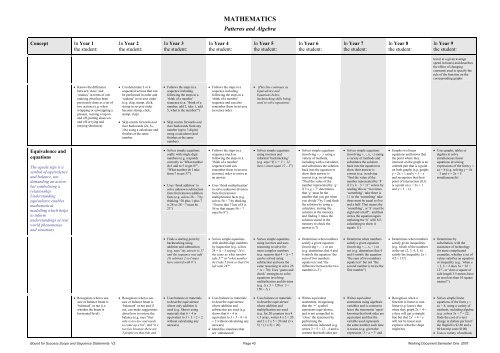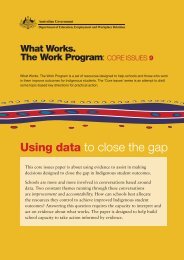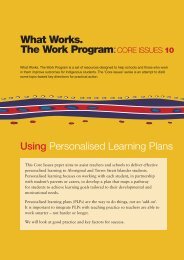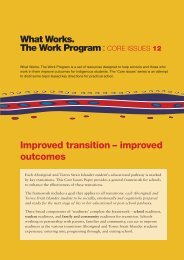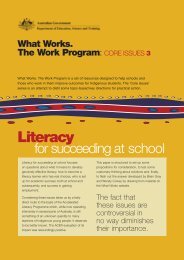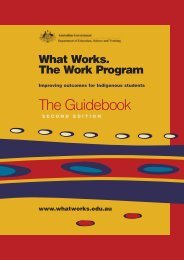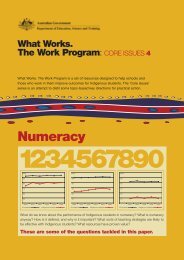Bound for Success Scope and Sequence Statements
Bound for Success Scope and Sequence Statements
Bound for Success Scope and Sequence Statements
- No tags were found...
You also want an ePaper? Increase the reach of your titles
YUMPU automatically turns print PDFs into web optimized ePapers that Google loves.
MATHEMATICSPatterns <strong>and</strong> AlgebraConcept In Year 1the student:In Year 2the student:In Year 3the student:In Year 4the student:In Year 5the student:In Year 6the student:In Year 7the student:In Year 8the student:In Year 9the student:travel at a given averagespeed in hours) <strong>and</strong> describesthe effect of changingconstants used to specify therule of the function on thecorresponding graphs• Knows the differencebetween ‘does’ <strong>and</strong>‘undoes’ in terms of oneundoing what has beenpreviously done as a set oftwo actions (e.g. whenwrapping or unwrapping apresent, turning a tap on<strong>and</strong> off, putting shoes on<strong>and</strong> off or tying <strong>and</strong>untying shoelaces)• Can determine 3 or 4sequential actions that canbe per<strong>for</strong>med in order <strong>and</strong>‘undone’ in reverse order(e.g. clap, stamp, click,stomp in reverse orderbecome stomp, click,stamp, clap)• Skip counts <strong>for</strong>wards <strong>and</strong>then backwards (2s, 5s,10s) using a calculator <strong>and</strong>finishes at the samenumber• Follows the steps in asequence includingfollowing the steps in a‘think of a number’sequence (e.g. “think of anumber, add 2, take 1, add5, what is the number?”)• Skip counts <strong>for</strong>wards <strong>and</strong>then backwards from anynumber (up to 3 digits)using a calculator (<strong>and</strong>finishes at the samenumber)• Follows the steps in asequence includingfollowing the steps in a‘think of a number’sequence <strong>and</strong> can alsoremember them in inverse(reverse) order• (This line continues asEquivalence <strong>and</strong>Equations below,backtracking skills beingused to solve equations)Equivalence <strong>and</strong>equationsThe equals sign is asymbol of equivalence<strong>and</strong> balance, notdem<strong>and</strong>ing an actionbut symbolising arelationship.Underst<strong>and</strong>ingequivalence enablesmathematicalmodelling which helpsto in<strong>for</strong>munderst<strong>and</strong>ings of realworld phenomenae<strong>and</strong> situations.• Solves simple equationsorally with single digitnumbers (e.g. respondscorrectly to ‘What numberdo I add to 5 to get 8?”,“What number do I takefrom 7 to get 3?”)• Uses ‘think addition’ tosolve unknown subtractionfacts from known additionfacts (e.g. solves 28 – 7 bythinking “20 plus 1 plus 7is 28 so 28 – 7 must be21”)• Follows the steps in asequence (such asfollowing the steps in a‘think of a number’sequence) <strong>and</strong> canremember them in inverse(reverse) order to arrive atan answer• Uses ‘think multiplication’to solve unknown divisionfacts from knownmultiplication facts (e.g.solves 56 ÷ 7 by thinking“I know that 7 lots of 8 is56 so that means 56 ÷ 7must be 8”)• Solves simple equationsusing inverses <strong>and</strong>in<strong>for</strong>mal ‘backtracking’(e.g. says “If ⌂ + 3 = 12then ⌂ must equal 12 – 3”)• Solves simple equations(involving +, - ) using avariety of methods,including with a calculator,<strong>and</strong> substitutes the solutionback into the equation toshow their answer iscorrect (e.g. in solving“Find the value of thenumber represented by ‘g’if 3 x g = 7” determinesthat ‘g’ must be thenumber that you get whenyou divide 7 by 3 <strong>and</strong> findsthe solution by using acalculator, storing thesolution in the memory<strong>and</strong> finding 3 times thesolution stored in thememory to check theanswer is 7)• Solves simple equations(involving +, -, x, ÷,) usinga variety of methods <strong>and</strong>substitutes the solutionback into the equation toshow their answer iscorrect (e.g. in solving“find the value of thenumber represented by ‘h’if 2 x h – 3 = 11” solves byreading this as “two times‘something’, take three is11 so the ‘something’ takethree must be equal to five<strong>and</strong> a half. That means the‘something’, or ‘h’ must beeight <strong>and</strong> a half”, <strong>and</strong> thenwrites the equation againreplacing the ‘h’ with 8.5,calculating to show itequals 11)• Graphs two linearequations <strong>and</strong> knows thatthe point where theyintersect on the graph is anordered pair that is a pointon both graphs (e.g. graphsy = 2x + 1 <strong>and</strong> y = 1 – x<strong>and</strong> recognises that theirpoint of intersection (0,1)is a point on y = 2x + 1<strong>and</strong> y = 1 – x)• Uses graphs, tables oralgebra to solvesimultaneous linearequations involvingexpressions of the <strong>for</strong>m y =ax + b (e.g. solving y = 4x– 3 <strong>and</strong> y = 2x + 5simultaneously)• Finds a starting point bybacktracking usingaddition <strong>and</strong> subtraction(e.g. says “my answer is 17<strong>and</strong> the sequence was add10, subtract 2 so I musthave started with 9”)• Solves simple equationswith double-digit numbersby inspection (e.g. solves24 = ∆ – 5 saying “24 isthe same as what numbertake 5?” or “what numberdo I take 5 from so that I’mleft with 24?”• Solves simple equationsusing inverses <strong>and</strong> usesreasoning to solve <strong>for</strong>more complex numbers(e.g. reasons that 4 + ∆ = 7can be solved usingsubtraction <strong>and</strong> uses thesame reasoning to solve 26+ ∆ = 70); Uses ‘guess <strong>and</strong>check’ strategies to solveequations involvingmultiplication <strong>and</strong> division(e.g. ∆ x 3 = 120 or 3 =150 ÷ ∆ )• Determines when numberssatisfy a given equation(involving +, - ) or not(e.g. determines that 4 <strong>and</strong>6 satisfy the equation ‘thesum of two numbersequals ten’ <strong>and</strong> ‘thedifference between the twonumbers is 2’)• Determine when numberssatisfy a given equation(involving +, -, x, ÷ ) ornot (e.g. determines that 4<strong>and</strong> 6 satisfy the equation“the sum of two numbersequals ten” but not “thesecond number is twice thefirst number”)• Determines when numberssatisfy given inequalities(e.g. which of the numbersin the set {2, 3, 4, 5, 6}satisfy the inequality 2x +4.5 > 11?)• Determines bysubstitution, with theassistance of technology<strong>for</strong> more complicatedexamples, whether a set ofvalues satisfies an equationor inequality (e.g. ‘when a= 3, b = 2 does 3a + 2b =12?’, or ‘does a square ofside length 3.5 metres havean area less than 10 squaremetres?’)• Recognises when a seesawor balance beam is‘balanced’ or not (i.e.whether the beam ishorizontal/level)• Recognises when a seesawor balance beam is‘balanced’ or not <strong>and</strong> ifnot, can make suggestionsabout how to restore thebalance (e.g. says “thatside is too low <strong>and</strong> needsto come up a bit”, <strong>and</strong> “it’stoo low because there are3 people on that side <strong>and</strong>• Uses balance or materialsto describe equivalencewhere only addition isused (e.g. Shows usingmaterials that 6 + 4 isequivalent to 3 + 3 + 2 + 2without calculating anyanswers)• Uses balance or materialsto describe equivalencewhere addition <strong>and</strong>subtraction are used (e.g.shows that 6 + 4 isequivalent to 3 + 5 - 4 + 6+ 2 without calculating anyanswers)• Identifies situations thatare ‘unbalanced’• Uses balance or materialsto describe equivalencewhere addition <strong>and</strong>multiplication are used(e.g. <strong>for</strong> 20 counters in a 4x 5 array, writes 4 x 5 = 20<strong>and</strong> 2 x 2 x 5 = 20 <strong>and</strong> (3 x5) + (1 x 5) = 20)• Writes equivalentstatements, recognisingthat the ‘=’ symbolrepresents equivalence,<strong>and</strong> is not compelled to‘close’ the statement byper<strong>for</strong>ming thecalculations indicated (e.g.writes 3 + 5 = 12 – 4 <strong>and</strong> iscontent that both sides are• Writes equivalentstatements using algebraicvariables <strong>and</strong> is content toleave the statements ‘open’knowing that both sides areequivalent <strong>and</strong> that thevariable used representsthe same number each timeit occurs (e.g. given theexpression ‘3 + a = ?‘ <strong>and</strong>• Recognises when afunction is linear or nonlinear(e.g. knows thatwhen they graph 2x + 4 =y they will get a straightline but that 2x 2 + 4 = ywill not be linear <strong>and</strong>explores what the shapemight be)• Solves simple linearequations of the <strong>for</strong>m y =ax + b, using a variety ofmethods, including algebra(e.g. solves 3x + 7 = 22;finds the cost of a taxicharge in dollars per km ifthe flagfall is $2.80 <strong>and</strong> a60 km trip costs $100)• Uses a variety of methods<strong>Bound</strong> <strong>for</strong> <strong>Success</strong> <strong>Scope</strong> <strong>and</strong> <strong>Sequence</strong> <strong>Statements</strong> V2 Page 43 Working Document Semester One 2007


